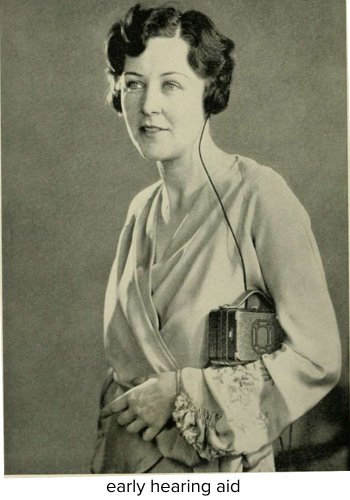Hearing loss has always been a part of life for humans – the earliest attempts at helping those with hearing difficulties can be traced back to the 17th century with ear trumpets. The ear trumpet came in a wide range of sizes, and they were made of various materials – from iron to animal horns.
In 1800, Frederick C. Rein made the first collapsible ear trumpet, the first to be produced and sold commercially. He also created acoustic headbands, which hid hearing help in a user’s hair.
It wasn’t until 1898 that Miller Rees Hutchison invented the Akouphone, which used an electric current to amplify weak signals. He was able to create the device by basing it on the telephone, which was invented in 1876. The Akouphone included a microphone, amplifier, headphones and battery – it was large and difficult to use, as well as expensive. However, it was used by Queen Alexandra of Denmark, who invited Hutchison to her husband’s coronation ceremony!

The next innovation in hearing aids was the vacuum tube, which was brought into hearing aids in 1920 when Earl Hanson patented the Vactuphone. This technology became widely available and was improved upon throughout the 1920s and 1930s. These devices had an amplifier and batteries that were worn around the neck and the microphone was handheld, which meant talking to others was a lot like interviewing them with a news microphone.
It was in the 1930s that the telecoil was added to hearing aids. Originally, the telecoil allowed hearing aid wearers to hear landline telephones, which emitted magnetic signals that the telecoil picked up and amplified into the wearer’s ear. Telecoils are still widely available in hearing aids today – but they are most often used with hearing loops to help wearers hear in public spaces and performance venues.
Next up was the transistor hearing aid, which was invented in 1948. These quickly replaced vacuum tubes, since they required less battery power and sounded much better. Improvements to the technology were needed quickly, though, since moisture stopped them from working just weeks after purchase. The development of a protective coating and a silicon transistor followed quickly.
 In 1970, the microprocessor was created, revolutionizing much more than just the hearing aid world. Edgar Villchur developed an analog multi-channel amplitude compression device that separated an audio signal into frequency bands and allowed for adjusting of volume at different frequencies. This is the first step toward the fully custom, prescription hearing aids we know today.
In 1970, the microprocessor was created, revolutionizing much more than just the hearing aid world. Edgar Villchur developed an analog multi-channel amplitude compression device that separated an audio signal into frequency bands and allowed for adjusting of volume at different frequencies. This is the first step toward the fully custom, prescription hearing aids we know today.
In 1982, an all-digital, real-time array processing hearing aid was developed at a research facility. It was bulky and included a minicomputer, digital array processor, FM transmitter and receiver! The development of digital chips and signal processing followed – but these devices continued to be too large and required too much power to be used in hearing aids.
Finally, in 1987, the first commercially available digital hearing aid was released by the Nicolet Corporation. It was not a success, but it did prove that digital hearing aids were possible and the development of hybrid analog-digital hearing aids and digitally controlled analog products began.
Today, prescription hearing aids are digital, tiny and amazingly advanced. Oticon’s latest hearing aid offerings, Oticon Own™ and Oticon Real™, both come with an onboard Deep Neural Network, a processing chip that uses an algorithm to process the entire soundscape. The DNN was trained using over 12 million sounds from real life so it can mimic how the brain processes sound and ensure the user has clarity and precision in hearing everything around them.
Most hearing aids today offer Bluetooth® technology, allowing users to connect directly to smartphones and stream phone calls and music into their hearing aids. Plus, the smallest hearing aids today are nearly completely invisible in the ear; and even larger ones are incredibly discreet.
As scientists continue to understand the brain’s role in hearing, hearing aid technology will no doubt continue to advance as it has for hundreds of years. Today, people with hearing loss have access to some of the most advanced commercially available technology on the market.
In 2022, the United States also introduced over-the-counter hearing aids, which are available without a prescription or hearing test. These devices offer a much lower technology level than the devices produced by companies like Oticon and sold through hearing instrument specialists or audiologists. They do, however, offer a lower price point and an introduction to the world of hearing assistive devices.
If you’re looking to try an over-the-counter hearing aid, we recommend getting a professional hearing assessment first, so you know your degree of hearing loss and can discuss your options with a professional before you purchase anything. HearingLife offers complimentary hearing assessments at most of our locations; click here to schedule one.

